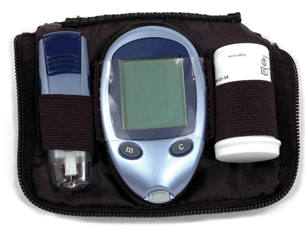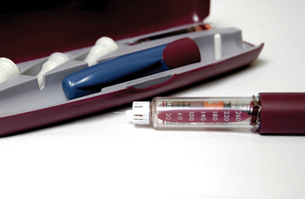Module 2
1. Module 2
1.40. Page 8
Module 2—The Endocrine System
 Lesson Summary
Lesson Summary

© Lisa A. Svara/shutterstock
Communication of information to and from a command centre in a battle is essential for success. The pancreas is like a command centre that monitors blood glucose. High levels of glucose stimulate the beta cells in the islets of the pancreas to secrete insulin, which increases the passage of glucose into body cells and promotes the conversion of glucose to glycogen in liver and muscle cells and to fat in the adipose cells. Low glucose levels stimulate the pancreatic alpha cells in the islets to secrete glucagon, which promotes the breakdown of glycogen to glucose and the release of this glucose into the bloodstream.
When the communication is disrupted, the battle may be lost. So it is with blood glucose regulation. If the beta cells are destroyed by an autoimmune disease, and little or no insulin is produced, consistently high blood glucose levels result in Type 1 diabetes. Left untreated, life-threatening consequences result.

© Daniel Gale/shutterstock
Regular glucose monitoring and insulin injections are the only treatment. Insulin cannot be taken in pill form because the digestive system would break it down before it could be absorbed.
If the pancreas sends out insulin, but the body cells ignore it (called insulin resistance), Type 2 diabetes results. Being very fat (obese) increases the cells inability to respond to insulin. The obvious treatment is to lose weight. Controlling diet and regular exercise can persuade the cells to respond to the insulin. In some cases, drugs have to be used.
Sometimes the pancreas secretes too much insulin and hypoglycemia occurs. The person becomes anxious or nervous, develops shakiness, and has a feeling of weakness. Continued hypoglycemia causes the brain to become disoriented, and may progress to unconsciousness and possibly death. If symptoms are recognized quickly, it is easily treated by eating candy, a source of glucose, or injecting glucagon.
Medical technologies for dealing with diabetes mellitus have progressed from glucose dipsticks to digital glucose monitors, and from syringes to insulin pens to insulin pumps. Research is being done into treating diabetes mellitus with islet transplants.
Lesson Glossary
Consult the glossary in the textbook for other definitions that you may need to complete your work.
alpha cells: cells in the islets that secrete glucagon
beta cells: cells in the islets that secrete insulin
diabetes mellitus: a serious chronic disorder that results when the pancreas does not produce enough insulin, insulin receptors, or body cells do not respond to insulin
Levels of blood glucose tend to rise sharply (spike) after meals (hyperglycemia) and remain at significantly elevated levels.
glucagon: a hormone secreted by the alpha cells in the islets of the pancreas that raises blood glucose levels by stimulating liver cells to convert glycogen to glucose; also stimulates fat cells (adipose cells) to convert fat to glucose
hyperglycemia: a condition resulting from high levels of blood glucose; occurs in individuals with diabetes mellitus
hypoglycemia: a condition resulting from low levels of blood glucose; occurs in individuals who secrete excessive amounts of insulin when a tumour develops in the beta cells or in diabetics who have injected too much insulin
insulin: a hormone secreted by the beta cells in the islets of the pancreas that lowers blood glucose levels by promoting the uptake of glucose by most cells of the body, and the synthesis and storage of glycogen in the liver; also stimulates protein and fat synthesis
islets of Langerhans (islets): clusters of alpha and beta cells that secrete glucagon and insulin, respectively, into the blood
pancreas: a gland with dual functions
The non-endocrine part secretes digestive enzymes into the intestine through the pancreatic duct, while the endocrine portion, called the islets of Langerhans, secretes insulin and glucagon into the bloodstream.
Type 1 diabetes (juvenile diabetes or insulin-dependent diabetes): an autoimmune disorder in which the immune system produces antibodies that attack and destroy the beta cells of the pancreas so that they are unable to produce insulin; usually diagnosed at an early age and the individuals require daily injections of insulin
Type 2 diabetes (adult-onset diabetes or insulin-independent diabetes): a disorder that develops slowly over time because the insulin receptors on the body’s cells stop responding to insulin or because the beta cells of the pancreas produce less and less insulin over time; appears to be related to being overweight or obese